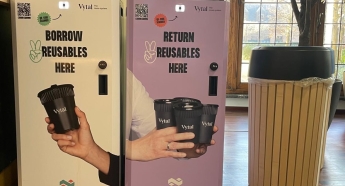Reusable packaging is the future, including for takeaways and food delivery. ‘It will definitely take some getting used to, for both restaurants and their customers. But for smart entrepreneurs it’s also an ideal opportunity to improve the customer experience and fully commit to sustainability,’ says Hélène Snyers, Re-Use Advisor at Fost Plus.
Takeaways and food delivery are growing ever more popular with today’s consumers. Unfortunately, this has its downside: a mountain of waste is generated, much of which is not recyclable and, in the worst case, ends up on the street or in the countryside. The government wants to do something about this.
The law is changing fast
The legislators are particularly targeting single-use plastic packaging. In Belgium, the federal government banned the sale of single-use plastic cups and cutlery in November 2024. Shortly afterwards, the regions made reusable cups and other catering materials mandatory for festival and event organisers.
The new European Packaging & Packaging Waste Regulation (PPWR) goes a step further still. For example, restaurants will have to allow consumers to bring their own packaging and will have to offer a reusable alternative for each product. A minimum level will also be set: by 2030, at least 10% of all products must be offered in reusable packaging. As well as the packaging being reusable, the restaurant operator must have a system in place to collect it.
‘This means that every restaurant will have to start using reusable packaging very soon. This presents numerous challenges for the sector, primarily in terms of logistics. How is all this packaging going to be returned? Who is going to collect and wash it? And what about food safety? Moreover, you can’t just replace one form of packaging with another. It’s a new way of doing things that both restaurants and consumers still have to get used to,’ emphasises Hélène Snyers.

Inspiration from practice
Fortunately, there are already plenty of practical examples to provide inspiration. Festivals and events are no longer imaginable without reusable cups, which have also proved their worth in other settings.
For example, the komida student restaurants at the University of Antwerp introduced the first reusable tubs for takeaway salads in 2015. ‘We’ve learnt a lot since then about what works and what doesn’t,’ says An Op de Beeck, General Coordinator. ‘For instance, we’ve moved from a deposit system to a library model, where you pay nothing if you return the tubs on time. If you don’t, a “fine” is deducted from your card that roughly covers the purchase price. We now have return boxes that the tubs can be put in, which is more convenient for users. The good news is that the cost is now comparable with that of single-use packaging. Starting next year, we’ll be rolling out a similar system for coffee cups and dessert pots.’
Experimenting in takeaway and delivery
There’s now also plenty of experimenting going on in the traditional takeaway and food delivery business. For example, Bavet launched a pilot project together with Deliveroo in autumn 2024 as part of the Green Deal Anders Verpakt. ‘Customers at Leuven restaurants were offered a discount code when they opted for reusable packaging,’ says Jelle Lissens, Food & Beverage Manager at Bavet. ‘The initial results were already encouraging: 6% took up the offer for home delivery, and the figure for takeaway was as high as 16%. We also received lots of enthusiastic responses on social media, which shows that the issue is very much alive. Even so, we have to admit that we’re currently seeing far too few packaging returns. Customers don’t have to pay a deposit at the moment, so there’s little incentive. Making it easy for consumers will therefore be an important point to consider for the future.’
In Mechelen, Boemerang, an initiative of the sheltered workshop MIVAS, the pizza-maker Kingslize and the city of Mechelen, has introduced a reusable pizza box. ‘In Belgium, we use more than 16 million pizza boxes every year, which often end up as residual waste,’ says Karin Verhaegen of MIVAS. ‘We had a reusable box designed for the project which keeps the pizzas nice and crispy and can be easily transported too. The plan is to develop a pooling system in which customers can return the boxes to various businesses, after which they will be collected centrally and cleaned. This will make things more convenient both for consumers and for the restaurants. During our first pilot, we completed 1,874 cycles in three months, 1,821 of which were for pizza box packaging. Those are great figures!’

Now is the time
‘While we still have a long way to go, we’re seeing a lot of developments in the market,’ concludes Hélène Snyers. ‘New applications and new players are appearing every day. If you want to start today, you would do well to join one of the many existing initiatives. There’s not much point trying to reinvent the wheel. For businesses that want to take the plunge, this may be the ideal time to get involved.’
- Packaging prevention and re-use will become a major challenge in all sectors in the years to come. Fortunately, there are an increasing number of companies that can help you do just that. Fost Plus brings them together in one handy tool and shows you the way to potential partners.
